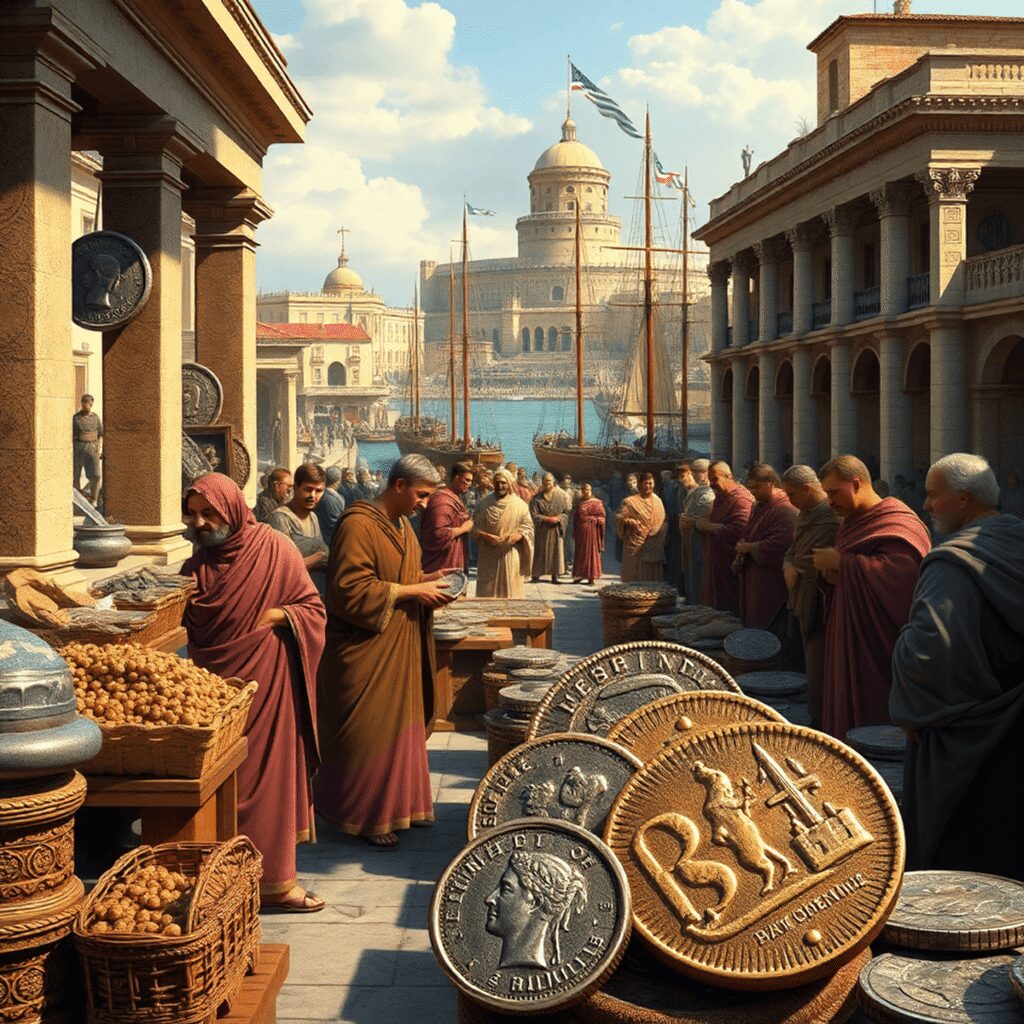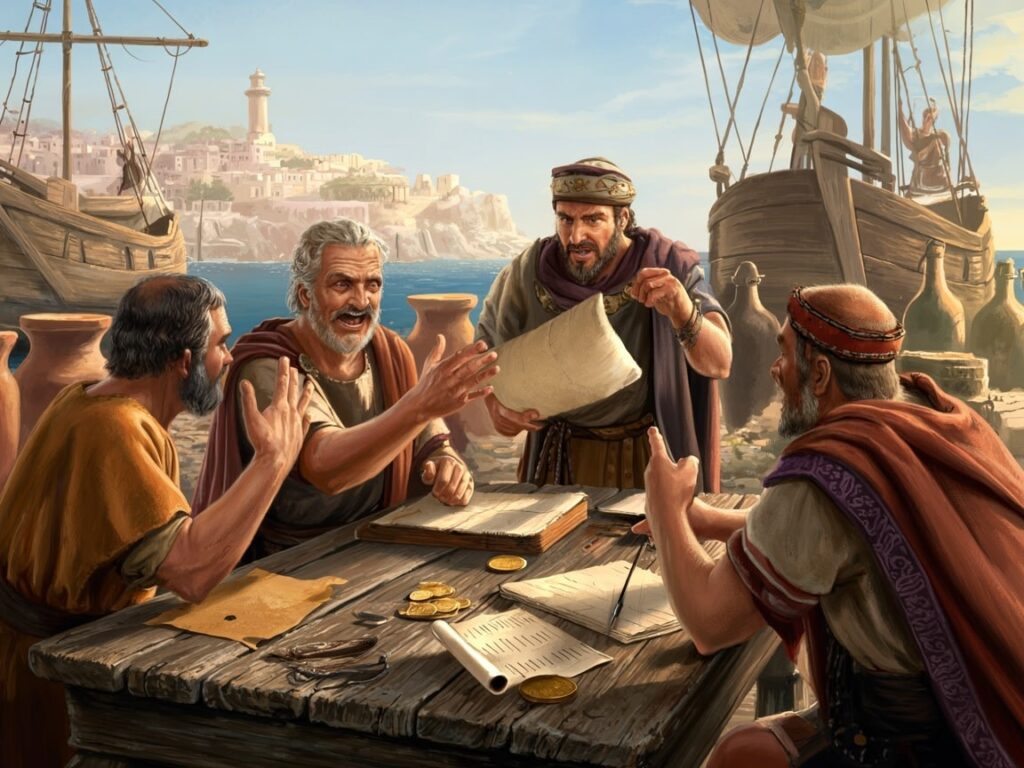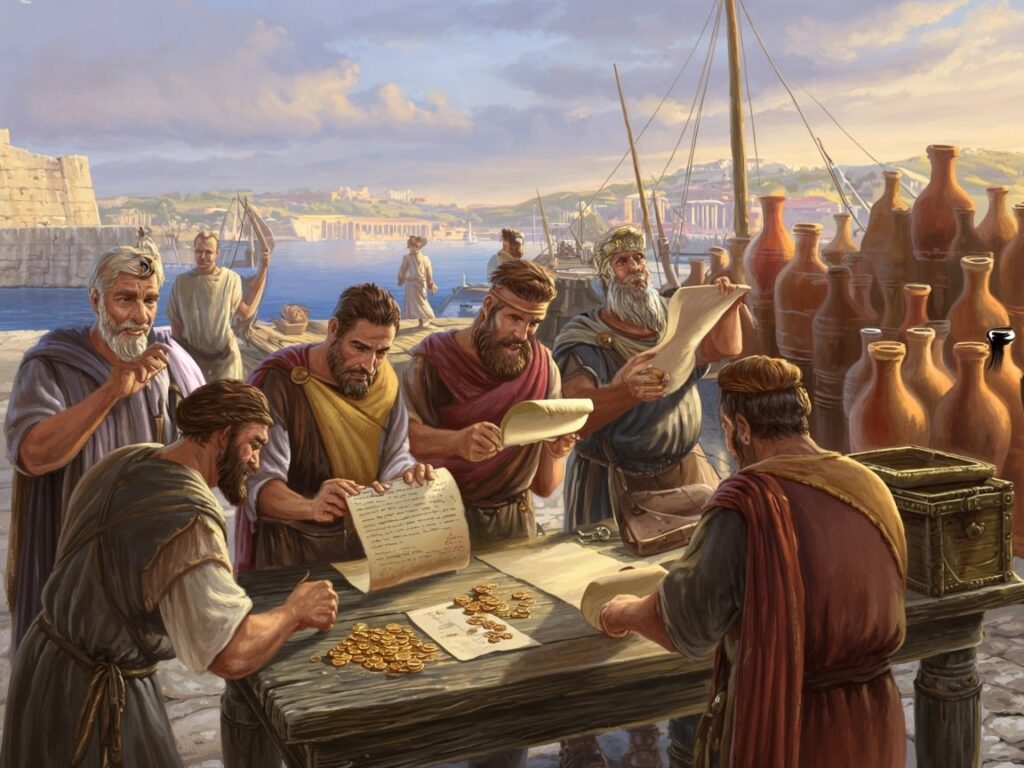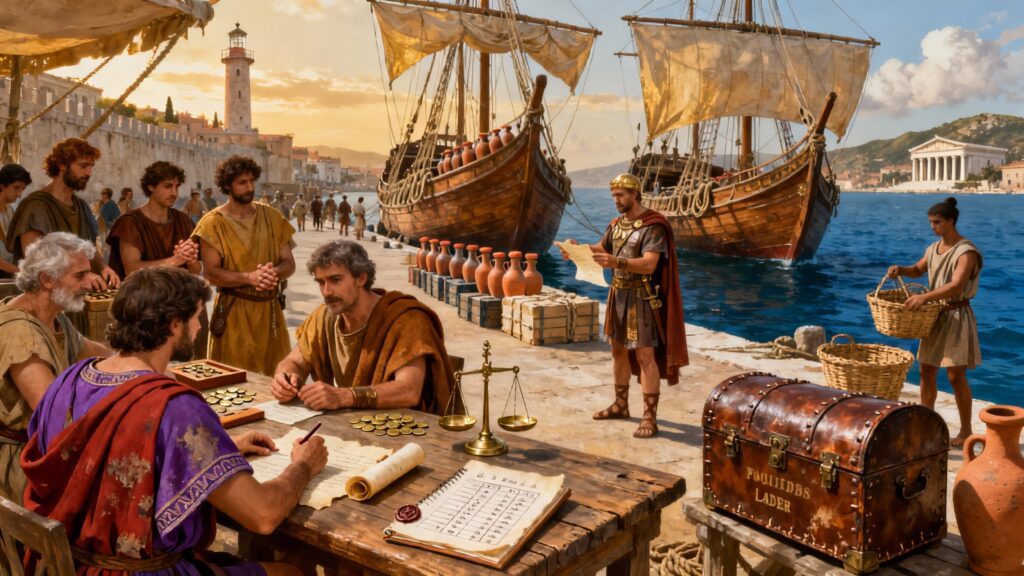Merchants and travelers in Ancient Rome faced numerous risks that threatened their livelihoods and safety. These dangers included shipwrecks, piracy, theft, and unpredictable natural events. The uncertainty surrounding long-distance trade and travel created a pressing need for financial protection mechanisms.
Ancient Roman insurance systems emerged as practical solutions to these challenges. By pooling resources and sharing risks, Roman merchants and travelers could mitigate potential losses. These early insurance forms helped stabilize commerce and fostered confidence in expanding trade networks.
A significant aspect of this commerce was the use of coins which served not only as a medium of exchange but also as a powerful tool for propaganda by emperors. These small pieces of currency went beyond their basic purpose and became significant instruments for political messaging.
Understanding how Ancient Romans built insurance systems for merchants and travelers reveals the roots of modern risk management practices. The principles established by Romans—such as mutual aid, contractual agreements, and risk sharing—laid the groundwork for today’s complex insurance industry. Exploring these foundations provides valuable insights into the evolution of financial protection against uncertainty.
The Economic and Social Context in Ancient Rome
The Roman economy thrived on extensive commerce and travel across a vast network connecting cities, ports, and provinces. Merchants transported goods such as olive oil, wine, grain, textiles, and precious metals along land routes and the Mediterranean Sea. Traveling merchants and traders were essential to maintaining the flow of goods that fueled urban centers and sustained military campaigns.
Political Instability’s Impact on Rome
However, this thriving economy was often overshadowed by periods of political instability and weak leadership, which served as a crumbling foundation for Rome. The decline of the Western Roman Empire serves as a stark reminder of how such internal strife can undermine even the most powerful civilizations.
Risks in Trade and Travel
Despite these challenges, the risks inherent to trade and travel posed constant challenges:
- Shipwrecks: Unpredictable weather, navigational errors, or structural failures could result in total loss of cargo and vessels.
- Theft: Banditry on roads and piracy at sea threatened both goods and personal safety.
- Piracy: Organized pirate groups targeted merchant ships, demanding ransom or stealing valuable merchandise.
Such hazards amplified the financial vulnerability of individual merchants. Without mechanisms to manage these risks effectively, many would face ruin from a single misfortune. The scale of Roman trade expansion created an urgent need for risk mitigation strategies that could distribute potential losses among multiple parties. Protecting investments against unpredictable dangers allowed merchants to undertake longer voyages and invest in bulk shipments without fearing catastrophic failure.
The Role of Early Insurance Systems
Understanding this context is crucial when examining how early insurance systems emerged to support commerce by addressing the very real threats embedded in Roman economic life.
Influence on Roman Sculpture
Moreover, these economic activities were often reflected in the evolution of Roman sculpture, which captured realism and power while serving as instruments for political propaganda and religious devotion.

Early Forms of Insurance Structures in Ancient Rome
The foundation of risk management in Ancient Rome rested on several practical and social mechanisms that allowed merchants and travelers to protect themselves financially.
1. Societas Partnerships
One key structure was the societas partnership, a form of merchant alliance where individuals pooled their resources. This collective investment meant that losses incurred by one member due to mishaps like shipwrecks or theft would be shared among all partners, reducing individual financial burdens. The societas arrangement not only spread risk but also encouraged larger, more ambitious commercial ventures.
2. Collegia Societies
Alongside societas partnerships, collegia societies played a vital role. These were benevolent associations formed by groups of individuals—often craftsmen, traders, or sailors—that offered mutual aid during times of distress. Members contributed regularly to a common fund, which could be drawn upon when someone faced hardship such as injury, loss of goods, or even death. Collegia functioned as early social insurance networks fostering community solidarity while providing essential financial support.
3. Informal Insurance Agreements
Beyond formal group structures, informal insurance agreements between individuals also shaped the Roman approach to risk. Trust-based arrangements allowed merchants and travelers to make verbal or written pacts for assistance in case of loss. Such agreements relied heavily on personal reputation and reciprocal cooperation within close-knit communities. These informal contracts promoted reliability and shared responsibility without requiring complex legal frameworks.
Together, these mechanisms created a robust system of mutual aid and risk sharing. This network of protection helped merchants and travelers navigate the uncertainties inherent in expanding trade routes across the Roman Empire.

Legal Framework Supporting Insurance-Like Contracts in Ancient Rome
The Roman law system provided a foundation for recognizing agreements that closely resembled modern insurance contracts. This legal recognition was essential for formalizing risk-sharing arrangements and protecting the interests of merchants and lenders involved in commercial ventures.
One of the most notable legal instruments was the foenus nauticum, a specialized type of maritime loan designed to address the inherent risks of sea travel. Unlike ordinary loans, the foenus nauticum included an interest rate that factored in the potential dangers faced during voyages, such as shipwrecks, piracy, or unpredictable weather conditions. This interest premium served as compensation for lenders who took on the risk of losing their capital if the ship failed to return safely.
Key Features of Foenus Nauticum
Key features of foenus nauticum included:
- Risk-based interest rates: The higher the perceived risk of the journey, the greater the interest charged.
- Conditional repayment: If the ship was lost at sea, the borrower was typically exempt from repaying the principal, transferring financial loss to the lender.
- Legal enforceability: These contracts were backed by Roman courts, which ensured adherence to agreed terms and protected parties from fraud or breach.
Through this framework, Roman merchants could secure funding for risky expeditions while lenders received compensation reflecting those risks. This arrangement not only encouraged investment in long-distance trade but also laid important groundwork for contractual risk transfer—a fundamental principle in modern insurance.
The foenus nauticum exemplifies how Ancient Romans built insurance systems for merchants and travelers by embedding risk considerations into legal financial agreements.

Mechanisms for Risk Sharing and Loss Mitigation Among Roman Merchants
Roman merchants used advanced methods of risk pooling and loss sharing arrangements to safeguard themselves against the significant dangers of trade and travel. These arrangements often took the form of collective ventures, where multiple investors or traders combined their resources to fund a single trading journey, particularly those involving long-distance sea trips filled with unpredictability.
Key Features of Roman Merchants’ Risk-Sharing Mechanisms
Here are some key features that made these risk-sharing mechanisms effective:
- Consortia Formation: Groups of merchants would come together to form consortia and finance larger trading ventures. By spreading the financial burden across several stakeholders, no single individual faced complete ruin if the venture failed due to shipwreck, piracy, or theft.
- Proportional Loss Sharing: Members agreed beforehand on how losses and profits would be divided. This clear understanding reduced disputes and promoted trust among participants.
- Joint Liability: In certain instances, all partners accepted joint liability for losses, which encouraged careful planning and risk assessment before undertaking risky ventures.
- Informal Agreements Backed by Social Norms: While some contracts were legally formalized, many risk-sharing agreements relied on established community trust and mutual expectations to ensure compliance.
Benefits of Risk Sharing for Roman Merchants
These systems lowered individual exposure by distributing potential losses across multiple parties. When a cargo was lost at sea or stolen during transit, no single merchant bore the entire financial blow. This diffusion of risk made it feasible to undertake more ambitious commercial activities—opening new markets and routes that might otherwise have been avoided due to fear of catastrophic loss.
Merchants’ ability to mitigate risk through these collective arrangements contributed significantly to the resilience and expansion of Roman trade networks. By embracing shared responsibility, they created a practical safety net that supported economic growth throughout the empire.

Impact on Roman Commerce and Travel Expansion: The Role of Early Insurance Systems
Early insurance systems played a crucial role in facilitating trade expansion across the Roman Empire. These mechanisms allowed merchants to venture into new and riskier markets with greater assurance. By reducing the financial threat posed by unpredictable dangers such as piracy or shipwrecks, merchants were more willing to engage in long-distance trade.
Key benefits included:
- Economic Stability Enhancement: The presence of risk-sharing arrangements contributed to a more predictable commercial environment. Merchants could better manage their capital without fearing complete loss from a single adverse event.
- Increased Confidence: Travelers and traders gained peace of mind knowing that losses from unforeseen incidents could be mitigated through collective support or contractual agreements. This security encouraged bolder trading strategies and the exploration of distant regions.
- Expansion of Trade Routes: As confidence grew, so did the development of extensive trade networks connecting diverse parts of the empire—from Mediterranean ports to inland cities.
The assurance provided by early insurance-like mechanisms was instrumental in sustaining economic growth and supporting the infrastructure needed for commerce and travel. Merchants no longer faced isolated risks but shared them within a community, creating a foundation for more ambitious commercial endeavors throughout Roman territories.
To understand the full impact of these early insurance systems, it’s essential to delve into the broader context of trade and economy in ancient Rome, which were foundational to its vast empire. This economic practices not only influenced daily life but also ensured long-term stability.
Moreover, the artistic legacy left behind by this era, as seen in the masterpieces of Roman art, reflects the cultural dynamics shaped by these economic activities.
Lastly, it’s worth noting that such extensive trade routes and economic strategies were often safeguarded by the formidable Roman military, which was not merely a collection of soldiers but a well-oiled apparatus combining discipline, strategy, and innovation.

Legacy of Roman Insurance Systems: Influences on Modern Risk Management Practices
The historical insurance development influence from Ancient Rome is evident in several key principles that underpin modern risk management. Roman practices introduced the idea of mutual aid, where members of a community or trade group would support each other financially during times of loss. This concept laid the groundwork for contemporary mutual insurance companies and cooperative risk-sharing models.
Contractual risk transfer, another cornerstone of Roman systems, has persisted through centuries. The foenus nauticum demonstrated an early form of assigning risk premium within legally binding agreements—an approach that echoes in today’s insurance contracts where risk and responsibility are carefully negotiated and priced.
Several foundational principles established by the Romans continue to shape how financial protection against uncertainty is understood:
- Pooling resources to spread risk among many participants, a concept that aligns with modern risk-sharing in pooled funds.
- Legal recognition of agreements designed to manage potential losses.
- Community-based support systems that reinforce trust and cooperation.
Roman innovations created a blueprint for handling commercial risks that informed medieval guilds, maritime insurance in the Renaissance, and ultimately modern insurance markets worldwide.
Interestingly, these early Roman practices were deeply entwined with their religious beliefs, as seen in the rituals and sacrifices they performed to appease their numerous gods. This belief system not only influenced their daily lives but also shaped their economic practices, including those related to risk management.
By studying How Ancient Romans Built Insurance Systems for Merchants and Travelers, you gain insight into the enduring legacy these early arrangements have on today’s sophisticated approaches to managing uncertainty in commerce and travel. Such an understanding also leads us to explore the depth of the Roman Pantheon, unveiling the gods of power, justice, and wisdom who played a pivotal role in shaping their societal structure and practices.
Conclusion
The Ancient Rome insurance legacy summary shows how Roman innovations in risk-sharing and financial protection laid the groundwork for today’s insurance systems. By creating mechanisms like societas partnerships, collegia mutual aid societies, and legal contracts such as foenus nauticum, Romans tackled the inherent dangers of trade and travel. These early frameworks lessened financial uncertainty for merchants and travelers, allowing for safer and broader trade networks throughout the empire.
Key takeaways from How Ancient Romans Built Insurance Systems for Merchants and Travelers include:
- The use of collective resource pooling to share losses
- Legal recognition of contracts that transferred risk through premiums
- The fostering of trust and cooperation within business communities
These strategies not only safeguarded individuals but also spurred economic growth by promoting long-distance trade. The legacy they left behind underscores the lasting importance of risk management principles, demonstrating that many contemporary insurance ideas can be traced back to the creativity of Ancient Rome.

FAQs (Frequently Asked Questions)
What risks did merchants and travelers face in Ancient Rome that necessitated early insurance systems?
Merchants and travelers in Ancient Rome commonly faced risks such as shipwrecks, theft, piracy, and other hazards during commerce and travel within the vast Roman Empire. These dangers created a critical need for financial protection mechanisms to safeguard trade and travel activities.
How did the concept of ‘societas’ function as an early form of insurance among Roman merchants?
‘Societas’ was a form of merchant partnership where resources were pooled together to share risks collectively. This arrangement allowed merchants to mitigate individual losses by distributing potential financial burdens across the group, effectively serving as an informal insurance system promoting trust and cooperation.
What role did Roman law play in supporting insurance-like contracts for maritime trade?
Roman law recognized contracts resembling modern insurance policies, notably through ‘foenus nauticum,’ a type of maritime loan with risk-based interest rates. This legal framework compensated lenders for potential losses due to unforeseen sea events, providing a structured approach to managing trade-related financial risks.
How did risk-sharing mechanisms among Roman merchants reduce exposure to financial ruin?
Roman merchants formed consortia and engaged in loss-sharing arrangements that pooled risks associated with large trading ventures. By distributing potential losses among multiple parties, these mechanisms minimized individual exposure to catastrophic financial setbacks caused by incidents like shipwrecks or cargo thefts.
In what ways did early insurance systems facilitate the expansion of trade and travel in Ancient Rome?
Early insurance systems enhanced economic stability and encouraged wider trade routes by providing protective measures against potential losses or disruptions. This increased confidence among merchants and travelers enabled long-distance commerce and travel across the expansive Roman Empire.
How have Ancient Roman insurance concepts influenced modern risk management practices?
Ancient Roman principles such as mutual aid, contractual risk transfer, and collective resource pooling laid foundational concepts for contemporary insurance. These early mechanisms continue to shape our understanding of financial protection against uncertainties, influencing the evolution of modern risk management frameworks.

